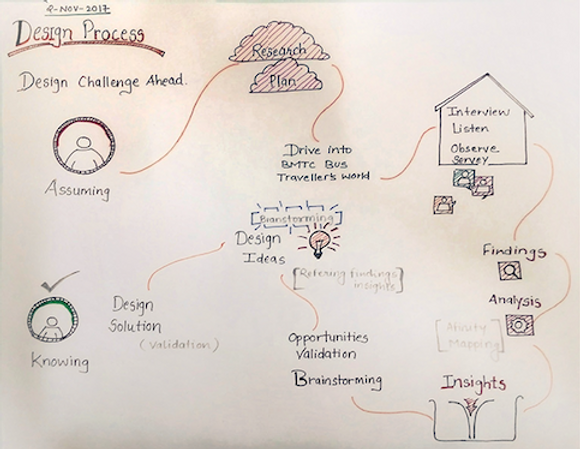ANUSHRI GHODE

AT THE BUS STOP
UX design | Design Research
PROBLEM :
Public transport bus stops don’t have a reliable system to communicate effectively with passengers. Often, buses do not halt at designated stops. Some buses on special routes have no fixed timings, so those who seek these buses have no way of knowing whether to wait or not. The footboard on some buses are so high that it is difficult for the elderly to board.
PROJECT DURATION :
3 weeks for total project time. The deliverables include a design document and a reflective documentation.

THE APPROACH

DESIGN PROCESS :
The project brief asked to pick any problem space(messy content ), investigate what sort of project future this space would have. Design a solution that answers to issues (mess). After a preliminary discussion narrowed initial focus to public transportation buses stops in Bangalore city.
STAKEHOLDER MAP

USER INTERVIEW :
User sample : 10
Method : Face to face
USER INTERVIEW :
User sample : 16
Method : Online form

AFFINITY MAPPING
Insides are collected from observation, interview and past experience to make affinity mapping.
IDEATION AND ITERATION :
From key insights, I visualized different ways of solving the problem. Also, it went over several rounds of sketching to formulate as many as solutions possible. Later, each solution is going over and various pros and cons of the designs are thought about.

FINAL SOLUTION :
Based on research, created a design proposal that tackles the problem not through a single product, but rather as a set of interventions in the environment. These take into account existing patterns and behaviors of the user to enhance their experience, rather than trying to create a new paradigm.

SIGNALLING ARRIVAL : Passengers tend to often check their phones or move to the curb to check for an incoming bus.
Display a board on bus stop which gives information of the next bus, like bus number, arrival time and bus route. This should hang on top of the bus stop so the people can see easily at their eye-level.
FIND YOUR ROUTE : Most of the time passengers don’t know the exact bus number or bus route. And sometimes, the information plate or board is written in the regional language which makes it difficult for the non-native people to read.
Display a board which helps the user to find the bus. On this board, the user have to choose or enter a destination by typing or by voice. Once the user enters the destination, he can get the route maps to the destination. From this, the user can select which route he wants to choose.
According to the route, the bus number and the fair will be displayed on the board. It will be inside the bus stop, next to the entry door.
On that display board, there will be an emergency button which people can use to directly contact the police or hospitals which are nearer to bus stop, in case of an emergency or accident.
ElLEVATED BUS STOP : It will be on an elevated level of the same height as the bus footboard, so the passenger can easily get in or out from bus.
TICKET COUNTER (KIOSK) : It will be on entry to the bus stop, where the passenger can get the ticket by himself.
PASSENGER NOTIFICATION : When a ticket is taken by passenger, that information goes to the driver. This way, he will get add-on information about the number of passengers from the particular bus stop.
BUS STOP EXIST : The exit of the passenger from the bus will be outside the bus stop.
SOLAR PANEELED ROOF AND CCT : CCTV camera for security. Solar panelled roof for electricity consumption.

TECHNOLOGY
Display screen used is E-INK display screen. Which is more reading useful than LCD.
E-INK Display board is lighter than LCD
E-INK is more durable and reliable than LCD
E-INK display 36 times more energy efficient than a similar sized LCD screen. This means that the amount of power used in LCD display for 20 hours would last 720 hours in E-INK.
The benefits of this are a huge reduction in energy consumption and carbon footprint.
HOW IT WILL WORK IN BANGALORE :
Crowd will be maintained inside the bus so that the passengers will not be on road. This will help in avoiding congestion.
In Bangalore, most of the people from outside the city don't know the regional language, the bus number or the bus route. The display screen will help them to find their route and bus.
The display board for the next bus will help the people know which bus will come next, so that they can feel relaxed.
Passengers feel relaxed, as the ticket has already been taken. The issue of not possessing the exact change, is also solved.
Driver will know that passengers are on the next bus stop. Thus they will stop the bus.
Reduces congestion on the bus stop as the passenger gets down from bus outside the bus stop.
Display screen using E ink technology helping in energy consumption.
LIMITATIONS :
Don’t know whether the queue system will work on bus stops or not. If the passenger wants to catch the next bus but if he was not on the queue, he may panic.
In the beginning stage, the users may need help about working of the display screen works (guidance needed)